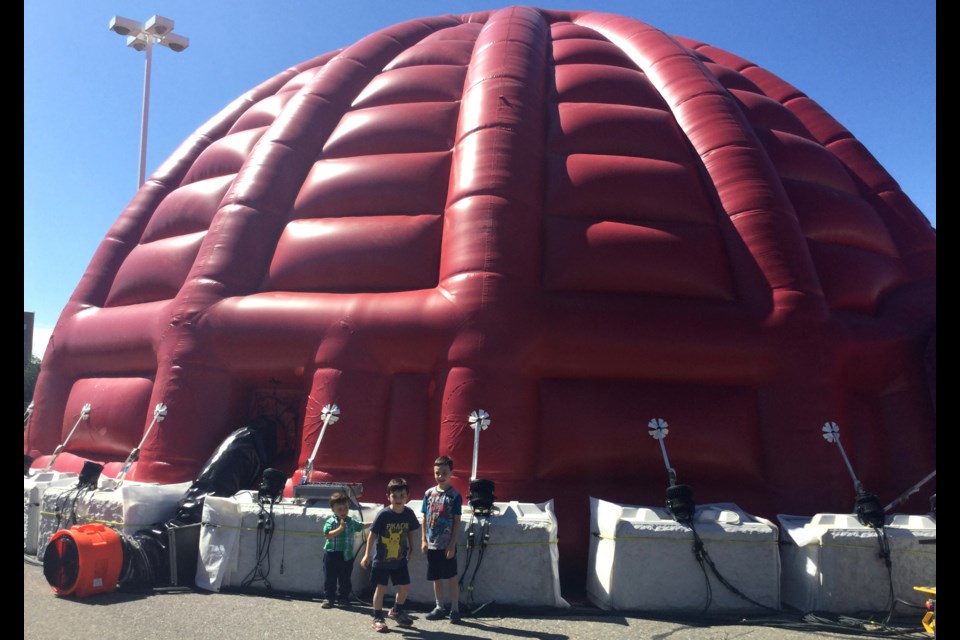Fifty years ago, SooToday's David Helwig was enthralled by a 360-degree film about Canada at Expo 67 in Montreal. In the bouncy igloo near Station Mall yesterday, Helwig saw something he considered 10 times better than that
In 1967, we were 100 years old.
But we were Canadians, so we were also young, beautiful and hopelessly groovy.
As a nation, we'd left our past behind us.
The eyes of the world were fixed on Canada at Montreal's Expo 67.
We were proud, ready to change the world.
Pierre Berton called 1967 our "last good year."
Looking back a half-century later, it seems that bit about leaving our past behind might have been a little premature.
But much of the shiny technological future displayed at the biggest world's fair of the 20th Century has definitely come to pass.
As a preadolescent from Ontario visiting Expo 67 with his dad, I stood wide-mouthed in the 20-storey U.S. pavilion, staring at full-scale mock-ups of the spacecraft that would land man on the moon just two years later.
I marveled at the swooping tensile roof of West Germany's pavilion, a design that would be emulated in 1992 in Sault Ste. Marie's Roberta Bondar Tent Pavilion.
In the Telephone pavilion, I saw demonstrations of technological marvels that became commonplace: touch-tone keypads, call-waiting, even a videophone – a primitive precursor to Skype.
The biggest attraction in the Telephone pavilion was a film.
It was called Canada 67, it ran 22 minutes and it was presented in Circle-Vision 360° format, with a 23-foot-high screen wrapping around us in a 273-foot-circumference full circle.
Canada 67 was one of the most popular offerings of Expo 67 and I remember standing in line for hours to see it.
My favourite scene was when they mounted nine cameras on top of an emergency vehicle and sent it speeding down a downtown street in Montreal or Quebec City, roof lights reflected back from every direction.
Unlike many of the other tech novelties exhibited at Expo 67, 360-degree cinema is still an impressive, leading-edge technology.
On Sunday, Saultites got their first look at Horizon: A 360-Degree Journey.
Shot in lavish 9K resolution in 35 locations in 13 provinces and territories, the film is projected on the interior of the hemispheric Sesqui inflatable dome.
Audible gasps from audience members could be heard during the breathtaking opening scene of silk dancers performing in an open field in Waterdown, Ont.
Some other scenes portray:
- synchronized swimmers at Tobermory's Fathom Five National Marine Park
- Acadian dancers in New Brunswick
- hip-hop dancers in Coe Hill, Ontario
- BMX riders in Saskatoon
- dragon boat racers on Rideau Canal in Ottawa
- caribou in northern Quebec
- Inuit throat singers in Ottawa's Remic Rapids Park
- ice sailing in Ghost Lake, Alta.
- modern-dance choreographer Margie Gillis performing at Sandbanks Provincial Park near Picton, Ont.
- sea lions in Haida Gwaii, B.C.
- skateboarders practicing at an underpass in Hamilton, Ont.
- an iceberg off Fogo Island, N.F.
- a trillium field in Richmond Hill, Ont.
- parkour outside Montreal's Olympic Stadium
- Royal Winnipeg Ballet
- Peggy's Cove, N.S.
- tides on the Bay of Fundy
- dog sledding in Aurora Village, Yellowknife, N.W.T.
Sault Ste. Marie is one of just seven Ontario communities that will receive free screenings this year in the Sesqui dome.
The film started showing in Toronto on June 21.
Since then, it's been to London and Windsor.
Screenings are planning in Thunder Bay July 24 to July 28, Richmond Hill Aug. 3 to Aug. 7 and Kingston Aug. 11 to Aug. 15.
Executive producer Andrea Stewart tells SooToday that Horizon was mostly shot on Red digital cameras, although other DLSR video cameras were employed and one scene had 30 GoPro cameras operating simultaneously
Stewart says Canada is a world leader in immersive film technology and it all traces back to Expo 67.
360-degree films were known prior to 1967. In fact, French cinematographers had dabbled with immersive technology since the late 1880s.
But it was the popularity of innovative immersive films at Expo 67, including Graeme Ferguson’s Polar Life and Roman Kroitor’s Labyrinthe, that led to the development of IMAX, a major Canadian success story with 1,102 theatres located in 69 countries.
The 360-degree technology used in Horizon was similarly a Canadian innovation, Steward told SooToday.
If you go
Free screenings of Horizon: A 360-Degree Journey will be available Monday to Wednesday from noon to 10 p.m., and on Thursday 10 a.m. to 7:30 p.m.
Admission is first-come, first-serve but lineups so far in the Sault have been considerably shorter than in other cities.
Note that screenings from 12 p.m. until 2 p.m. are allocated for schools and camps.
The dome is designed to provide an immersive experience for 45 people.
For the best seats, turn left as you enter the inflatable structure and sit facing the entrance.
The Sesqui cinematic dome is supported by the Province of Ontario as an Ontario 150 event and by the Government of Canada as a Canada 150 signature initiative.
